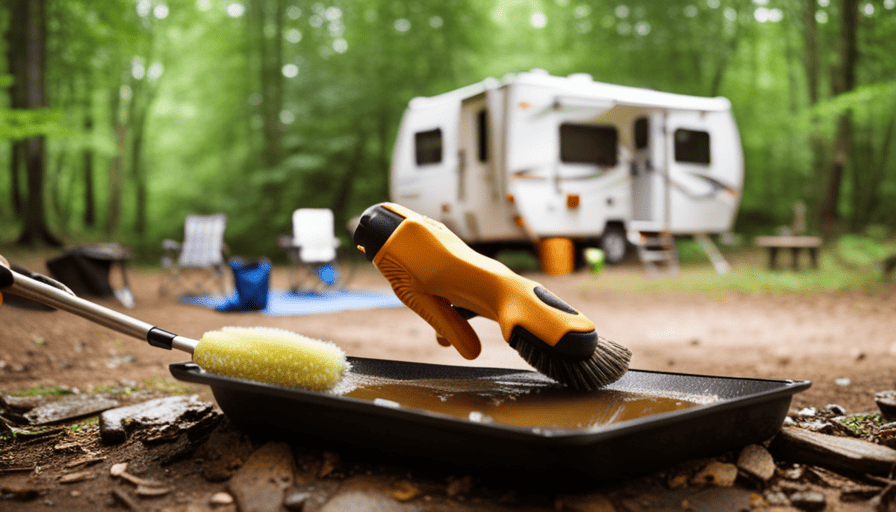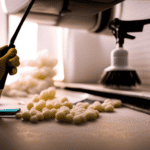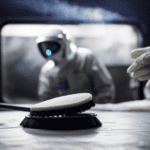Are you passionate about taking your camper out on the open road but loathe the idea of having to clean the canvas once your journey ends? Worry not! In this article, I’ll walk you through a detailed tutorial on cleaning your camper’s canvas, ensuring it looks pristine and brand-new. I’ll discuss everything from assembling your cleaning materials to properly storing your canvas.
First, we will start by preparing a cleaning solution and removing any dirt and debris from the canvas. Then, we will tackle any stubborn stains that may have accumulated over time.
Next, we will scrub the canvas thoroughly, ensuring that every inch is cleaned to perfection. Properly drying the canvas is crucial to prevent any mold or mildew growth, and I will show you the best techniques for doing so.
For those looking for extra protection, I will also share an optional step on how to apply a protective coating to the canvas.
Lastly, I will provide you with some valuable tips for regular maintenance and cleaning to keep your camper canvas looking its best.
So, let’s get started and make your camper canvas shine!
Key Takeaways
- Regular cleaning with a soft brush or broom helps to remove light dirt and dust from the camper canvas.
- For tougher stains, a mixture of mild soap and warm water can be used, avoiding harsh chemicals and abrasive scrubbers.
- Homemade cleaning solution made with warm water, mild dish soap, and white vinegar can be used to scrub the canvas.
- Properly drying the canvas is crucial to prevent mold growth and maintain durability, by air drying in a well-ventilated area and avoiding direct sunlight or using a dryer.
Gather Your Cleaning Supplies
Now that you’ve gathered all your cleaning supplies, it’s time to roll up your sleeves and get to work on cleaning your camper canvas. Cleaning the canvas of your camper is essential to maintain its longevity and keep it looking its best.
There are several cleaning techniques you can use, depending on the level of dirt and stains on the canvas. For light dirt and dust, a soft brush or broom can be used to gently sweep away the debris. For tougher stains, a mixture of mild soap and warm water can be applied using a soft cloth or sponge. It’s important to avoid using harsh chemicals or abrasive scrubbers as they can damage the canvas.
Regular cleaning is crucial as it helps prevent the growth of mold and mildew, which can cause damage to the canvas material. Once you’ve thoroughly cleaned the canvas, it’s time to prepare the cleaning solution for the next step of the cleaning process.
Prepare the Cleaning Solution
First, gather all the ingredients needed to concoct the perfect cleaning solution for your beloved camper canvas. When it comes to cleaning your canvas, you want to opt for homemade cleaning solutions that aren’t only effective but also eco-friendly. Start by grabbing a bucket and filling it with warm water. Add a few drops of mild dish soap, as this’ll help break down any dirt or grime on the canvas without causing damage. For an extra boost of cleaning power, you can also include a quarter cup of white vinegar. This natural ingredient not only helps remove stains but also acts as a disinfectant. Mix the solution together until it’s well blended.
Using a soft-bristled brush or a sponge, dip it into the cleaning solution and gently scrub the canvas in a circular motion. Be sure to cover all areas, including the seams and corners. Pay extra attention to any stubborn stains or spots. Once you’ve thoroughly cleaned the canvas, rinse it off with clean water to remove any soap residue. Wipe away excess water with a clean cloth and allow the canvas to air dry completely.
With your homemade cleaning solution prepared, it’s time to move on to the next step: removing dirt and debris from your camper canvas.
Remove Dirt and Debris
To truly rid your treasured home-on-wheels of the stubborn grime and pesky debris, you’ll need to unleash your inner cleaning warrior and banish every last speck of dirt from every nook and cranny of your cozy abode.
When it comes to cleaning camper canvas, there are a few techniques that can help you achieve a spotless result. Start by using a soft-bristled brush or a broom to gently remove any loose dirt and debris from the canvas. Be thorough and make sure to reach all the corners and crevices.
Once the loose dirt is gone, you can move on to a deeper clean. Mix a solution of mild soap and warm water, and using a sponge or a soft cloth, gently scrub the canvas in a circular motion. Rinse thoroughly with clean water and allow it to dry completely before folding or storing. This cleaning technique not only removes dirt but also helps in preventing future damage to the canvas.
Once your canvas is clean and dry, you can move on to the next step of treating any stains that may be present on the surface.
Treat Stains
Once you’ve conquered the grime, it’s time to tackle any stubborn stains that may have taken up residence on your beloved home-on-wheels. When it comes to treating stains on your camper canvas, there are a few effective techniques you can try.
One popular method is using a mixture of mild detergent and warm water. Simply apply the solution to the stained area and gently scrub it with a soft brush or sponge. For tougher stains, you can try using a specialized stain remover designed specifically for canvas materials. Be sure to follow the instructions on the product and test it on a small, inconspicuous area first to ensure it doesn’t cause any damage.
To prevent future stains on your camper canvas, it’s important to take some preventative measures. One effective way is to regularly apply a waterproofing spray to the canvas. This will create a protective barrier that repels water and prevents stains from setting in. Additionally, try to address any spills or stains as soon as they occur to minimize their impact.
With the stains treated, it’s time to move on to the next step: scrubbing the canvas.
Scrub the Canvas
Now that you’ve conquered the grime and treated the stains, it’s time to roll up your sleeves and give the canvas a good scrubbin’. Cleaning the canvas of your camper is essential for its maintenance and longevity.
Here are four effective cleaning techniques to ensure your canvas stays in top shape:
-
Use a soft-bristle brush: Gently scrub the canvas using a soft-bristle brush. Start from the top and work your way down, making sure to cover all areas. This will help remove any remaining dirt or debris.
-
Mild soap and water: Create a mixture of mild soap and water in a bucket. Dip the brush into the soapy water and scrub the canvas in circular motions. Pay extra attention to any stubborn stains or areas that need extra cleaning.
-
Spot cleaning: For tougher stains, use a specialized canvas cleaner or a mild stain remover. Apply a small amount directly to the stain and gently scrub with the brush. Be careful not to use too much force, as it may damage the canvas.
-
Rinse thoroughly: After scrubbing the canvas, rinse it thoroughly with clean water. Use a hose or a bucket to remove any soap residue. Make sure to rinse both the inside and outside of the canvas to ensure a complete clean.
Now that the canvas is clean, it’s time to move on to the next step: rinsing thoroughly. This will ensure that all the soap and cleaning agents are removed, leaving your canvas fresh and ready for the next adventure.
Rinse Thoroughly
Make sure you give the canvas a thorough rinse, ensuring that every bit of soap and cleaning agents are completely removed. Deep cleaning is essential to remove any dirt, grime, or mildew that may have accumulated on the canvas. Not only does rinsing help to keep your camper canvas looking clean, but it also plays a crucial role in preventing mold growth. Mold can thrive in damp environments, and if left untreated, it can cause damage to the canvas and even pose health risks.
To thoroughly rinse the canvas, start by spraying it with clean water using a hose or pressure washer. Make sure to cover every inch of the canvas, paying extra attention to the seams and corners where dirt can easily accumulate. Use a gentle spray to avoid damaging the fabric.
To help you visualize the rinsing process, refer to the table below:
| Area | Spray Pattern | Water Pressure |
|---|---|---|
| Main Canvas | Wide and even | Low |
| Seams | Focused stream | Medium |
| Corners | Circular motion | High |
After rinsing thoroughly, move on to the next step of drying the canvas properly.
Dry the Canvas Properly
Ensure you give that fabric a good drying session, because a soggy canvas is about as useful as a screen door on a submarine. Properly drying the canvas is essential to prevent mold growth and maintain its durability.
After rinsing the canvas thoroughly, follow these canvas drying techniques to ensure it’s completely dry.
First, hang the canvas in a well-ventilated area. Choose a spot where there’s good air circulation, such as a clothesline or a sturdy tree branch. This’ll help speed up the drying process and prevent the formation of mold.
Next, allow the canvas to air dry naturally. Avoid using a dryer or exposing it to direct sunlight, as this can cause the canvas to shrink or fade. Instead, let the air do its job and evaporate the moisture from the fabric.
If you’re in a hurry or the weather isn’t cooperating, you can use a fan to help expedite the drying process. Position the fan so it blows air directly onto the canvas, ensuring all areas are evenly dried.
Once the canvas is completely dry, you can proceed to the next step of applying a protective coating (optional). This’ll help enhance the longevity of the canvas and provide an extra layer of protection against the elements.
Apply Protective Coating (Optional)
For added durability and protection, you might consider applying a protective coating to your canvas, which can help extend its lifespan in various weather conditions. A protective coating provides a barrier against UV rays, moisture, and mildew, ensuring that your camper canvas remains in good condition for years to come.
Here are three reasons why applying a protective coating is beneficial:
-
Enhanced Waterproofing: A protective coating creates a waterproof barrier on the canvas, preventing water from seeping through and causing damage. This is especially important during heavy rain or snowfall.
-
UV Protection: The sun’s powerful UV rays can fade the colors of your canvas and weaken its fibers over time. A protective coating acts as a sunscreen, shielding the canvas from harmful UV radiation and preserving its vibrant appearance.
-
Mold and Mildew Prevention: Moisture and humidity can lead to the growth of mold and mildew, which can cause stains, odors, and even health issues. A protective coating inhibits the formation of mold and mildew, keeping your canvas clean and fresh.
While a protective coating offers significant benefits, there are alternatives to consider. Some campers prefer using waterproof sprays or treatments specifically designed for canvas. These products can provide similar waterproofing and UV protection benefits without the need for a full coating. Additionally, proper maintenance, regular cleaning, and storing the canvas correctly can also help extend its lifespan.
To ensure the longevity of your camper canvas, it’s essential to store it correctly.
Store the Canvas Correctly
Storing the canvas properly is like giving it a cozy nest to hibernate in, ensuring it stays snug and protected until its next adventure. Proper canvas storage is crucial in preventing mold and mildew growth, which can damage the fabric and create an unpleasant odor.
To start, make sure the canvas is completely dry before storing it. Any moisture trapped in the fabric can lead to mold and mildew formation. If the canvas is wet, allow it to air dry in a well-ventilated area before packing it away.
Next, fold the canvas neatly to avoid any creases or wrinkles. This will help preserve the integrity of the fabric and prevent any potential damage. It’s also important to store the canvas in a cool, dry place. Avoid storing it in a damp or humid environment, as this can promote mold and mildew growth.
Additionally, consider using a breathable storage bag or cover to protect the canvas from dust and debris while allowing air circulation.
By following these proper canvas storage techniques, you can ensure that your camper canvas remains in good condition and is ready for your next camping trip. Regular maintenance and cleaning tips will help keep your canvas looking its best and extend its lifespan.
Regular Maintenance and Cleaning Tips
To keep your canvas in top shape, remember to regularly maintain and clean it so it stays fresh and ready for your next adventure.
One important aspect of maintaining your camper canvas is preventing mold growth. Mold can be a common issue, especially if your canvas gets wet and isn’t properly dried. To prevent mold, make sure to thoroughly dry your canvas after each use. If you do notice any signs of mold, it’s important to act quickly. Mix a solution of one part vinegar and three parts water, and use a soft-bristle brush to gently scrub the affected area. Allow the canvas to air dry completely before folding it up for storage.
Another common issue with camper canvas is stubborn stains. Whether it’s dirt, food, or other spills, it’s important to tackle stains as soon as possible to prevent them from setting in. Start by gently blotting the stain with a clean cloth or paper towel to remove any excess liquid. Then, mix a solution of mild soap and warm water. Use a soft-bristle brush to gently scrub the stain in a circular motion. Rinse the area thoroughly with clean water and allow it to air dry. For particularly tough stains, you may need to repeat this process or use a specialized stain remover.
By regularly maintaining and cleaning your camper canvas, you can ensure it stays in great condition for years to come.
Frequently Asked Questions
How often should I clean my camper canvas?
I clean my camper canvas regularly to ensure its longevity. I use a soft brush or sponge, mild soap, and warm water to clean the fabric. I gently scrub the fabric in a circular motion, paying special attention to any stains or dirt buildup. Regular maintenance is crucial as it prevents mold, mildew, and damage caused by environmental elements. By cleaning my camper canvas regularly, I can enjoy a clean and durable fabric for years to come.
Can I use bleach to remove stains from the canvas?
Yes, bleach can be used to remove stains from camper canvas. However, it’s important to note that bleach can be harsh and may damage the canvas material. If you prefer to avoid using bleach, there are alternative DIY stain removers that can be effective. For example, mixing vinegar and water can help remove stains without causing damage. Additionally, using a mild detergent and scrubbing gently with a soft brush can also be an effective stain removal method.
Is it necessary to apply a protective coating after cleaning the canvas?
After cleaning the canvas, it’s highly recommended to apply a protective coating. Think of it as armor for your camper canvas, shielding it from future stains, dirt, and UV rays.
The benefits of a protective coating are immense. It prolongs the lifespan of the canvas, makes it easier to clean in the future, and enhances its overall appearance.
While there are alternative cleaning methods, a protective coating adds an extra layer of defense, ensuring your canvas stays in top-notch condition.
What should I do if the canvas becomes moldy?
If the canvas becomes moldy, it’s important to take immediate action to prevent further growth and damage. First, I’d remove the canvas from the camper and carefully inspect it for any signs of mold. Then, I’d use natural cleaning solutions like vinegar or hydrogen peroxide to kill the mold spores and remove any visible mold. After cleaning, I’d thoroughly dry the canvas to prevent future mold growth. Regularly inspecting and cleaning the canvas can help prevent mold from becoming a problem in the first place.
Can I machine wash the canvas?
No, you can’t machine wash the canvas. It can damage the fabric and cause it to lose its waterproofing abilities. Instead, there are alternative cleaning methods you can try.
Start by brushing off any loose dirt or debris. Then, mix a mild soap with warm water and use a soft brush or cloth to gently scrub the canvas. Rinse thoroughly and allow it to air dry completely before storing or using again.
What Is the Best Way to Clean a Camper Awning and Canvas?
When it comes to cleaning your camper awning, the best approach is to start with a thorough sweep to remove any loose dirt or debris. Next, mix a solution of mild soap and water, and gently scrub the surface using a soft brush or sponge. Rinse thoroughly with a hose, and let it air dry completely before retracting. Regular cleaning of your camper awning will help maintain its appearance and prolong its lifespan.
Conclusion
In conclusion, cleaning your camper canvas is essential to maintain its longevity and appearance. By following the steps outlined in this article, you can effectively remove dirt, treat stains, and scrub the canvas to restore its original shine.
Remember to always dry the canvas properly and consider applying a protective coating for added durability. Additionally, proper storage and regular maintenance are key to keeping your camper canvas in top shape.
So, don’t let the grass grow under your feet – take care of your canvas and enjoy many more camping adventures!



















